The poin - Study guides, Class notes & Summaries
Looking for the best study guides, study notes and summaries about The poin? On this page you'll find 409 study documents about The poin.
Page 3 out of 409 results
Sort by
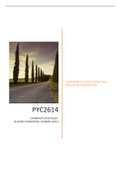
-
Bullet point form summary that covers all of the PYC2614 2022 study material. Everything you need to pass with distinction!
- Summary • 20 pages • 2022
-
- $11.36
- 3x sold
- + learn more
Bullet point form summary that covers all of the PYC2614 2022 study material. Everything you need to pass with distinction!

-
Relias - Fetal Heart Monitoring Questions and Answers 2023 1. A deceleration that begins after the onset of a uterine contraction, reaches its nadir (lowest point) after the peak of the contraction and takes at least 30 seconds to reach its lowest p
- Exam (elaborations) • 26 pages • 2024
- Available in package deal
-
- $17.99
- + learn more
Relias - Fetal Heart Monitoring Questions and Answers 2023 1. A deceleration that begins after the onset of a uterine contraction, reaches its nadir (lowest point) after the peak of the contraction and takes at least 30 seconds to reach its lowest point is defined as: Select Your Answer: a. Early deceleration b. Abrupt deceleration c. Non-reassuring deceleration d. Late deceleration e. Variable deceleration - >>ANSWE
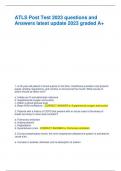
-
ATLS Post Test 2023 questions and Answers latest update 2023 graded A+ 1. A 45-year-old patient is found supine on the floor. Healthcare providers note pinpoint pupils, shallow respirations, and vomitus in and around the mouth. What course of action shoul
- Exam (elaborations) • 26 pages • 2024
-
Available in package deal
-
- $7.99
- + learn more
ATLS Post Test 2023 questions and Answers latest update 2023 graded A+ 1. A 45-year-old patient is found supine on the floor. Healthcare providers note pinpoint pupils, shallow respirations, and vomitus in and around the mouth. What course of action should be taken next? a. Initiate an IV and administer naloxone b. Supplemental oxygen and suction c. Obtain a blood glucose level d. Begin BVM ventilations - CORRECT ANSWER-b. Supplemental oxygen and suction 2. Patients with a history of COPD tha...
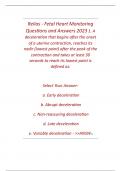
-
Relias - Fetal Heart Monitoring Questions and Answers 2023 1. A deceleration that begins after the onset of a uterine contraction, reaches its nadir (lowest point) after the peak of the contraction and takes at least 30 seconds to reach its lowest p
- Exam (elaborations) • 26 pages • 2024
-
Available in package deal
-
- $19.49
- + learn more
Relias - Fetal Heart Monitoring Questions and Answers 2023 1. A deceleration that begins after the onset of a uterine contraction, reaches its nadir (lowest point) after the peak of the contraction and takes at least 30 seconds to reach its lowest point is defined as: Select Your Answer: a. Early deceleration b. Abrupt deceleration c. Non-reassuring deceleration d. Late deceleration e. Variable deceleration - >>ANSWE
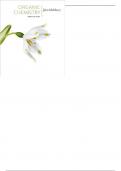
-
Test Bank For Organic Chemistry 9th Edition by John E. McMurry
- Exam (elaborations) • 555 pages • 2023
-
Available in package deal
-
- $33.18
- 2x sold
- + learn more
Chapter 01 - Structure and Bonding 1. Give the ground-state electron configuration for carbon (atomic number 6). 1s22s22px12py1 or 1s22s22p2 2. Give the ground-state electron configuration for fluorine (atomic number 9). ANSWER: POINTS: 1 1s22s22px2 2py2 2pz1 or 1s22s22p5 3. Give the ground-state electron configuration for magnesium (atomic number 12). 1s22s22p63s2 4. How many electrons does silicon have in its valence shell? ANSWER: four POINTS: 1 Exhibit 1-1 Write valid Lewis (elec...
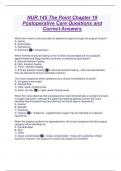
-
NUR 145 The Point Chapter 19 Postoperative Care Questions and Correct Answers
- Exam (elaborations) • 9 pages • 2024
-
Available in package deal
-
- $8.99
- + learn more
Which method of wound healing is one in which wound edges are not surgically approximated and integumentary continuity is restored by granulation? A. Second-intention healing B. First- intention healing C. Third - intention healing D. Primary intention healing A. Second-intention healing - when wounds dehisce, they are allowed to heal by secondary intention The nurse recognizes which symptoms as a clinical manifestation of shock? A. Increased urine output B. Flushed face C. rapid, weak, thready...
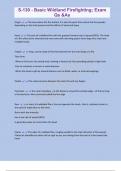
-
S-130 - Basic Wildland Firefighting; Exam Qs &As Origin The area where the fire started. It is also the point from which the fire spreads, depending on the fuels present and the effects of wind and slope. Head The part of a wildland fire with the greate
- Exam (elaborations) • 53 pages • 2024
- Available in package deal
-
- $16.99
- + learn more
S-130 - Basic Wildland Firefighting; Exam Qs &As Origin The area where the fire started. It is also the point from which the fire spreads, depending on the fuels present and the effects of wind and slope. Head The part of a wildland fire with the greatest forward rate of spread (ROS). The head of a fire often burns intensely and may move with alarming speed. Some large fires may have multiple heads. Fingers long, narrow strips of fire that extend from the main body of a fire. They f...
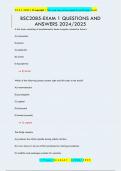
-
descibe the human anatomical position → The human body is erect with feet only slightly apart, head and toes pointing forward, arm hanging at the sides with the palm facing forward The thoracic cavity is ______ to the abdominal cavity. → Superior The tra
- Exam (elaborations) • 19 pages • 2024
-
- $12.49
- + learn more
A skin layer consisting of predominantly dense irregular connective tissue is A) corpuscular B) dermis C) epidermis D) stratal E) hypodermis → B) dermis Which of the following planes creates right and left sides to the body? A) transtrabecular B) parasagittal C) sagittal D) horizontal E) frontal (coronal) → C) sagittal The Golgi complex A) produces the mitotic spindle during cellular division B) is now known to be an artifact produced by staining procedures C) modifies and p...
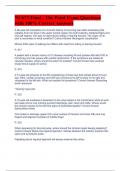
-
NU673 Final - The Point Exam Questions with 100% Correct Answers
- Exam (elaborations) • 17 pages • 2023
-
- $13.99
- + learn more
A 68-year-old complains of a 3-month history of recurring pain after ambulating that radiates from her back in the upper lumbar region into both buttocks, bilateral thighs and mid-calf regions. Her pain is improved by sitting or leaning forward. The origin of her pain is secondary to what condition? Correct Answer Neurogenic claudication Mimics PAD (pain r/t walking) but differs with relief from sitting or leaning forward P. 517 A patient with a known history of CV disease including MI ...
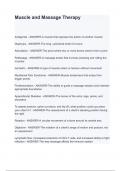
-
Muscle and Massage Therapy Antagonist - ANSWER-A muscle that opposes the action of another muscle Diaphysis - ANSWER-The long, cylindrical shaft of a bone Articulation - ANSWER-The point where two or more bones meet to form a joint Petrissage - ANSWER-A m
- Exam (elaborations) • 22 pages • 2024
-
- $7.99
- + learn more
Muscle and Massage Therapy Antagonist - ANSWER-A muscle that opposes the action of another muscle Diaphysis - ANSWER-The long, cylindrical shaft of a bone Articulation - ANSWER-The point where two or more bones meet to form a joint Petrissage - ANSWER-A massage stroke that involves pressing and rolling the muscles Isometric - ANSWER-A type of muscle action or tension without movement Myofascial Pain Syndrome - ANSWER-Muscle tenderness that arises from trigger points Professionalism - AN...

Study stress? For sellers on Stuvia, these are actually golden times. KA-CHING! Earn from your study resources too and start uploading now. Discover all about earning on Stuvia


